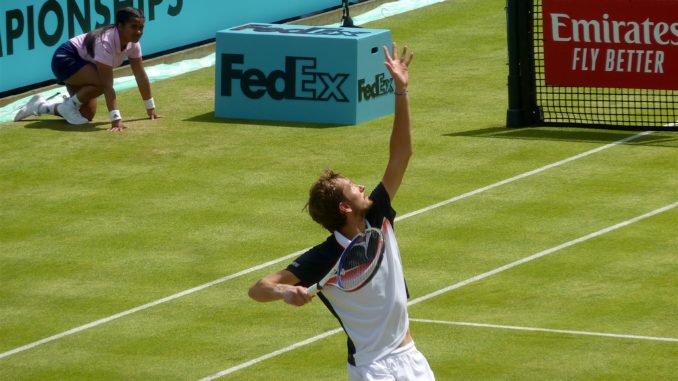
Written by Tyler Park (@ty_park8)
Edited by Ricky Dimon
Recently, Daniil Medvedev has done nothing but win tennis matches. The star of the ATP’s summer swing, he played four U.S. hard-court events and reached the final of all four—including the U.S. Open.
For a brief moment, however, it looked like he would not make it that far at the Cincinnati Masters. In the semis against world No. 1 Novak Djokovic, Medvedev appeared to be heading for a fate well-known to most Djokovic opponents: a straightforward loss. The Russian dropped the first set 6-3. He was exhausted from another long week of matches. He had nothing to lose.
So he tried something that seemed crazy.
Over the last two sets of the match, Medvedev decided to hit aggressive “first serves” on both his first and second serves. His serves, both first and second, scorched in at upwards of 120 mph—risking double-faults to try to elicit weaker returns from Djokovic. His average second serve speed increased by 11 mph in the second and third sets.
“Usually I’ll go bigger on my second serve when it’s not working, and Novak was just destroying me in the first set,” Medvedev explained afterward. “At one moment, I said to myself, why do a normal second serve if I’m going to lose the point. I started to win much more after that.”
The result was a shocking upset—a 3-6, 6-3, 6-3 win for the underdog Medvedev against an immovable opponent who usually never relinquishes a lead. Djokovic, who can solve almost any problem on a tennis court, was totally befuddled by Medvedev’s unusual strategy.
“I did not experience this too many times in my career that someone goes so big on second serves, and basically just plays two first serves for an extended period of time,” the top-ranked Serb said. “When someone serves a 128 mph second serve, you just have to congratulate him.”
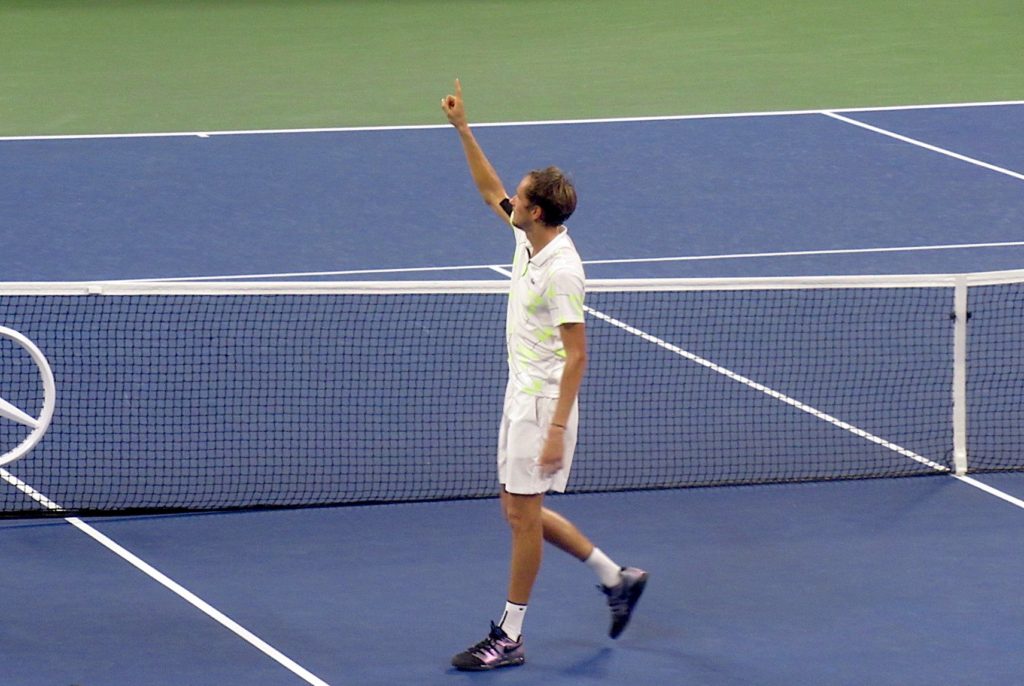
There were a few factors that made this strategy successful for Medvedev, who went on to defeat David Goffin in the final, winning the biggest title of his career. The first is that Medvedev is a good server. He hits the ball hard and flat, and his height (6’6”) gives him more margin for error above the net than most players. The second is that Medvedev was having an unusually accurate serving day; despite using this unique strategy, he finished the match with 14 aces and only four double-faults. And finally, Djokovic is a spectacular returner, generally acknowledged to be the best of all time. He combines impossible flexibility with incredible reflexes, and he uses these skills to devour second serves for breakfast. In the last 12 months, Djokovic has won an absurd 55.2 percent of his second-serve return points—third on tour behind only Rafael Nadal and Diego Schwartzman. He has ranked in the top five of this statistic for each of the last 10 seasons. There’s a reason why he’s No. 1 in the world.
Medvedev’s willingness to think outside the box has separated him from the other players of his generation. He has unorthodox strokes; in an era of heavy topspin, he hits the ball hard and flat off both his forehand and backhand. He’s also willing to say and do things that are unconventional at best, and downright rude at worst.
But on this Cincinnati occasion, he was onto something. And it makes one wonder…what if a tennis player decided to always hit two first serves?
Conventional wisdom is that a player should avoid double-faults at all costs. On a basic level, it makes sense; by hitting a double-fault, you have a zero-percent chance of winning the point. By putting the ball in the box, you have at least some chance of winning the point—no matter how weakly the serve is hit.
But against a guy like Djokovic, even when you put a second serve in the box, your chances of winning that point just aren’t that good.
So is, at least in some cases, time for something new? Plenty of other sports have seen radical changes in strategy over the years (defensive shifts in baseball being the main example, while massive increases in passing in football and shooting three-pointers in basketball are others); can tennis also use statistics to help overcome outdated conventional thinking?
One possibility is this: “The Medvedev Method.” Or in less exciting terms, hitting two first serves.
The Medvedev Method
| Player | 1st Serve % | Win % on First Serve | Win % on Second Serve | Med. Method Win % |
| Novak Djokovic | 65.5% | 75.9% | 57.2% | 49.7% |
| Rafael Nadal | 64.6% | 75.7% | 59.8% | 48.9% |
| Roger Federer | 63.3% | 78.2% | 58.2% | 49.5% |
| Daniil Medvedev | 58.7% | 75.3% | 54.3% | 44.2% |
| Dominic Thiem | 63.4% | 72.8% | 55.2% | 46.2% |
| Alexander Zverev | 65.1% | 74.8% | 44.7% | 48.7% |
| Stefanos Tsitsipas | 62.6% | 75.8% | 52.8% | 47.5% |
| Kei Nishikori | 62.8% | 70.2% | 54.5% | 44.1% |
| Karen Khachanov | 64.0% | 73.7% | 52.8% | 47.2% |
| Roberto Bautista Agut | 65.4% | 72.3% | 55.2% | 47.3% |
*Stats are as of 9/15/19
The above table shows the serve statistics for each of the ATP’s top 10 players over the last 12 months. Double-faults are included in the second-serve win rate; they are counted as points lost on second-serves. The last statistic is the win rate using the Medvedev Method of hitting two first serves.
Here’s the formula: (1st-serve % x 1st-serve win %) = Medvedev Method win %
This analysis assumes that the player has already missed his first serve. If he employs the MM, his win rate is equal to the probability that he makes the aggressive serve multiplied by the probability that he wins the point once he does make the serve. Of course, the obvious downside is that if the serve doesn’t go in, it’s a double-fault.
Take Djokovic at the top of the table. His MM Win Rate is 65.5% x 75.9% = 49.7%. This compares to his 57.2% win rate using a traditional second serve. From these numbers, you can see that the strategy doesn’t make any sense for Djokovic.
This is probably because Djokovic is so strong from the baseline that he doesn’t need a dominant serve to have a good chance of winning the point and thus doesn’t need the MM. The same conclusion appears true for other elite baseliners like Nadal and Kei Nishikori, but it does not apply to every top player.
The case of Alexander Zverev
World No. 6 Alexander Zverev represents a very interesting example. Zverev has a lot in common with Medvedev; both are 6’6”, with uncommon mobility and high-velocity strokes. There are also differences, though. Zverev may be slightly more powerful, and his shots have more topspin. Meanwhile, Medvedev hits the ball flatter but with more consistency.
For this exercise, however, the main difference is Zverev’s serving pattern. A lanky, springy German, Zverev hits an effective first serve that can reach 135 mph. The stats back this up, as he ranks No. 20 among 85 qualified ATP players in first-serve win rate.
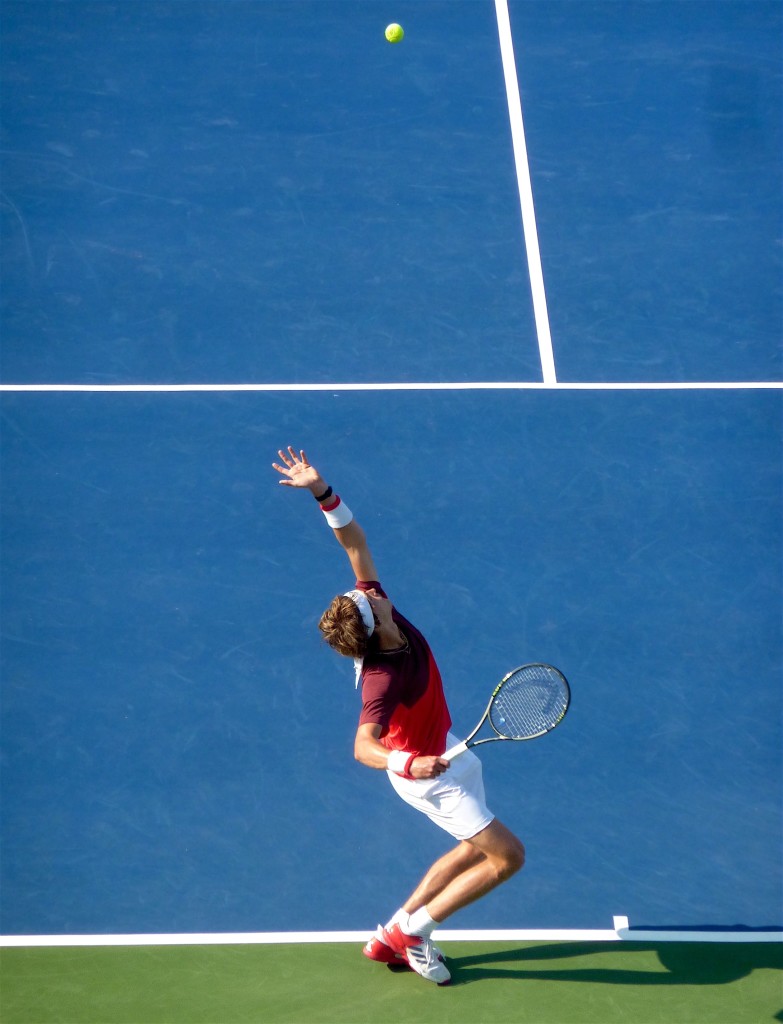
However, he falls apart once he misses his first serve. In his recent U.S. Open match against Schwartzman, Zverev double-faulted 17 times. Some of his second serves came in below 70 mph. These trends are not uncommon for Zverev, as he ranks 85th—dead last—among eligible players in second-serve win rate and 84th in avoiding double-faults.
Analysts have speculated that this is a mental issue for Zverev, a version of the “yips” that felled Chuck Knoblauch and Rick Ankiel on the baseball field and briefly Tiger Woods in the chipping game on the golf course. While this is very unfortunate for Zverev, it does make him the perfect subject for the Medvedev Method.
The data shows that Zverev would win a full four percent more points on his second serve by using the MM. This may not sound much, but in the U.S. Open final Nadal won just 52 percent of the total points compared to Medvedev’s 48 percent. That four percent can be the difference between winning and losing a match.
More subjectively, Zverev could easily afford to risk more double-faults by hitting more aggressive second serves; he already hits a ton of double-faults as it is! He might as well win more of the points when that second serve does go in, right?
Would the Medvedev Method work better for big servers?
| Player | 1st Serve % | 1st Serve Win % | 2nd Serve Win % | MM Win % |
| John Isner | 71.0% | 80.6% | 56.4% | 57.2% |
| Milos Raonic | 62.9% | 84.0% | 58.1% | 52.8% |
| Reilly Opelka | 63.6% | 80.4% | 54.3% | 51.1% |
| Nick Kyrgios | 66.4% | 78.8% | 50.9% | 52.3% |
| Kevin Anderson | 64.2% | 79.6% | 51.7% | 51.1% |
| J.M. Del Potro | 65.6% | 76.8% | 48.9% | 50.4% |
It is also worth testing the statistics on the biggest servers on tour. The MM depends on a strong first serve that wins many more points than the typical second serve, and when it comes to serving these guys are the strongest of the strong.
The above table includes the five best servers on tour according to the ATP’s “Serve Rating.” I also added Juan Martin Del Potro, another big server and former top 10 player who has fallen down the rankings due to injury.
Interestingly, the data shows that the strategy has a lot more merit for this set of players than for the top 10. Three of the six—John Isner, Nick Kyrgios, and Del Potro—would theoretically benefit from hitting two first serves.
Some fans would certainly dislike this change, as some of these heavy hitters have been derisively nicknamed “serve-bots” for their heavy reliance on their serves, and the MM would obviously lead to even more aces and double faults.
But this strategy isn’t just about the serve. The main reason Del Potro’s first serve is so effective is because it makes it difficult for the returner to keep the ball away from his forehand, which has earned him the nickname “Del Thortro” from Roger Federer for its hammer-like power.
Or is it really “The Bublik Method”?
| Player | 1st Serve % | 1st Serve Win % | 2nd Serve Win % | MM Win % |
| Alexander Bublik | 57.7% | 75.9% | 45.9% | 43.8% |
Alexander Bublik shares several traits with Zverev. They are both tall and slim Russian-born players, although Bublik represents Kazakhstan in competition. They even share a nickname—Zverev is nicknamed Sascha, while Bublik goes by Sasha.
Bublik’s statistical profile also indicates that he might be a good candidate to try the Medvedev Method. In fact, he does try it—more than Medvedev, and more than anyone else on tour! While the stats are not as overwhelming as they are for Zverev, Bublik’s second-serve win rate and his MM win rate are close enough that he might benefit from using the strategy in the right circumstances.
Bublik, of course, has already figured this out. In last week’s Chengdu Open final against Pablo Carreno Busta, he hit a whopping 31 aces along with 11 double-faults, in part due to his implementation of the MM. Included in those 31 aces was a 137 mph second-serve ace in the third-set tiebreak, a brazen MM serve if there ever was one.
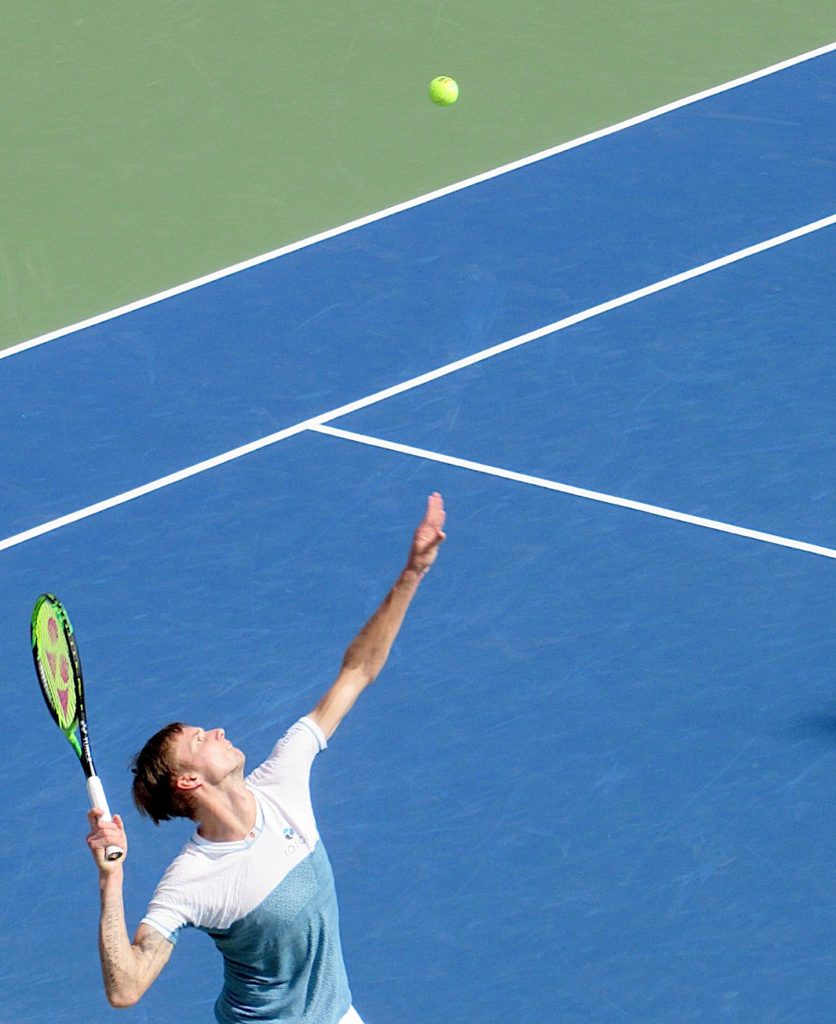
Although Bublik eventually lost the match, he undoubtedly benefitted from his adoption of the MM. He won 55 percent (24/44) of his second-serve points, well above his season average of 45.9 percent. If you remove the double-faults, his second-serve win rate was 72.7 percent— just a hair below his season first-serve win rate of 75.9 percent. Scorching in above 130 mph, his MM second serves were effective enough to offset the negative impact of the double-faults.
Bublik hasn’t played enough matches to qualify for the ATP’s official serve stats leaderboard, but if he did qualify he would lead the tour in double-faults per match, even ahead of Zverev. He hits two first serves fairly regularly and is an even more devoted user of the Medvedev Method than Medvedev himself.
Bublik is just 22 years old, and after reaching the Chengdu final he reached a career-high ranking of No. 57. A talented up-and-comer, fans should expect him to continue to rise in the rankings—and with his rise we should see many more examples of the MM.
The Return Element
| Player | 1st Serve % | 1st Serve Return Win % | 2nd Serve Return Win % | MM Return Win % |
| Novak Djokovic | 61.9% | 33.4% | 55.2% | 58.8% |
| Rafael Nadal | 61.9% | 36.5% | 55.9% | 60.7% |
| Diego Schwartzman | 61.9% | 32.8% | 55.7% | 58.4% |
| John Isner | 61.9% | 21.8% | 41.0% | 51.6% |
| Reilly Opelka | 61.9% | 21.8% | 41.4% | 51.6% |
Successful adoption of the Medvedev Method also depends on the opponent. The table above shows the numbers for the three best returners on tour—Djokovic, Nadal, and Schwartzman—as well as two of the worst—Isner and Reilly Opelka. I used the tour average first-serve percentage of 61.9 for each player and showed each of their first-serve and second-serve return win rates. The MM return win rate formula is below.
MM Return Win % = (Returner’s 1st-serve win rate * tour average 1st-serve %) + (1 – tour average 1st-serve %)
To spell it out, that’s the returner’s 1st serve win rate multiplied by the probability that the serve lands in, plus the probability of a double-fault.
The first thing the data shows is that it’s completely pointless to use the MM against a weak returner like Isner or Opelka. These players’ return games are so poor that you can hold serve just fine against them using a traditional second serve.
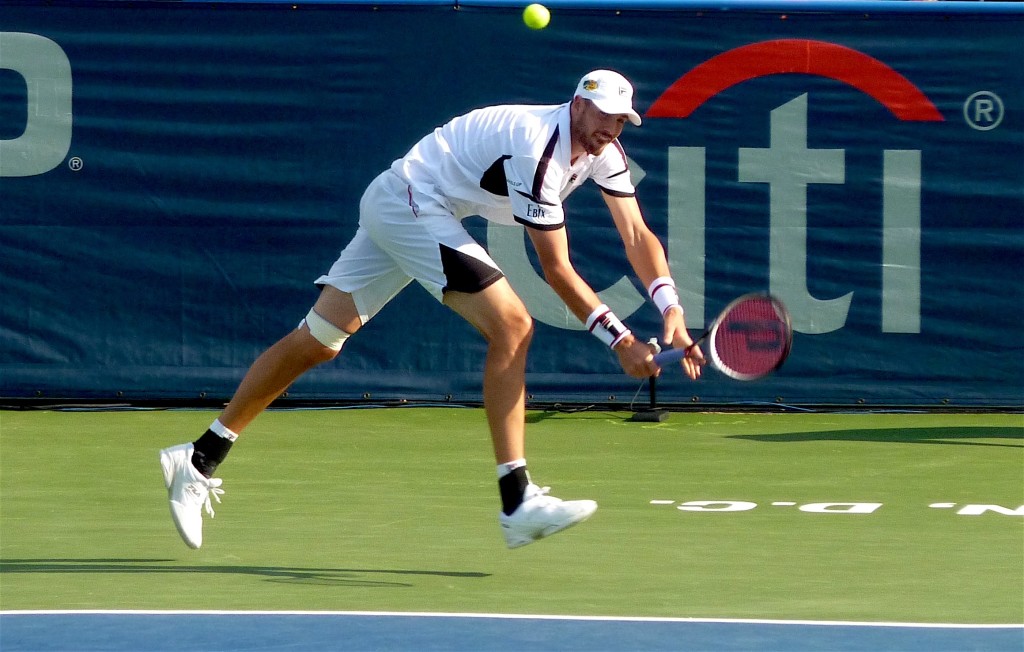
Against an elite returner, the numbers are much closer. Remember, these numbers are based on the returner’s stats against a tour average player. A player with a more accurate or more powerful first serve than the tour average could benefit from deploying the Medvedev Method against these elite returners.
The Verdict
This somewhat simplified statistical model likely doesn’t factor in all of the psychological elements that also go into the Medvedev Method.
For instance, the method would require a player with the mental fortitude to withstand those first few double-faults—and the criticism that would undoubtedly come from adopting this strategy. The player would have to commit to the strategy and the notion that he is coming out ahead in the long run.
On the other hand, the method would undoubtedly be frustrating to play against. Even Djokovic, who usually imposes his will on all his opponents, was thoroughly frustrated by Medvedev’s tactics in Cincinnati. That frustration could lead to more opponent unforced errors.
The real answer is likely that the Medvedev Method can be deployed effectively in particular situations. Take Medvedev’s match against Djokovic, for example. The current world No 4 has a strong first serve, he was serving accurately, and he was up against an elite returner. These are probably the ideal conditions for the MM. The numbers show the Medvedev himself is not a player who fits this strategy’s statistical profile, yet the fact that he had success indicates that many players could use it in the right situation.
This tactic could also be used as a surprise attack. Imagine you’re a going up against Medvedev and he has been hitting regular sub-100 mph second serves the whole match. If he suddenly hits a 130 mph second serve, you would have little chance of reacting well enough to hit an effective return. The closest analogy is a baseball catcher who has been crossed up; when you are expecting a fastball and get a curveball, it’s nearly impossible to react quickly enough. Similarly, a batter has little chance of hitting a 100 MPH fastball when you are expecting an 80 MPH curveball.
Even if a player isn’t willing to commit to hitting two full first serves, this data clearly shows that big servers would benefit from being more aggressive with their second serves. As bad as double-faults look and as costly as they can be, donating a few over the course of a match will be worth it if you are increasing your percentage of points won when you do make that second serve!
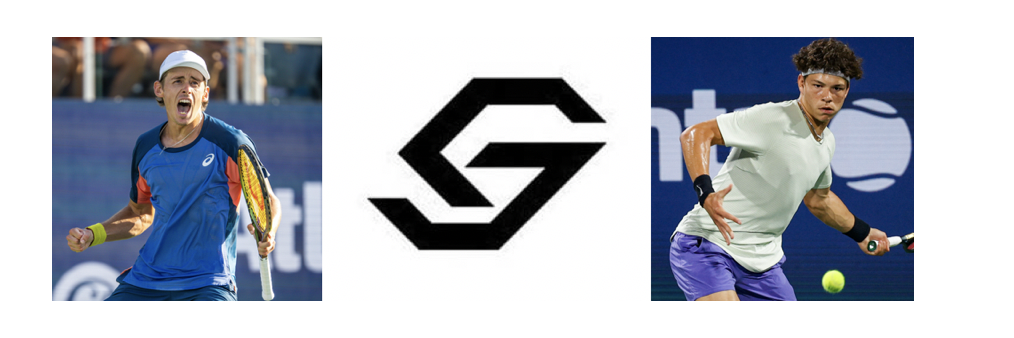

good stuff, Tyler!